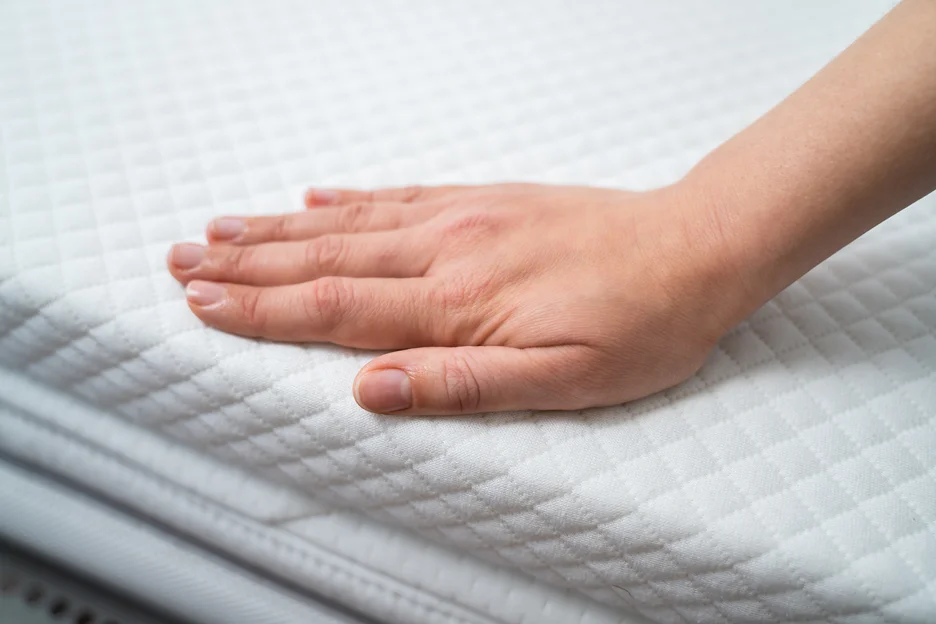Your Guide to Sleeping with Sciatica
If you’ve ever experienced the searing, shooting pain that radiates from your lower back down through your butt and leg, you know the agony of sciatica all too well.
That telltale sciatic nerve pain can make it incredibly difficult to get comfortable, fall asleep, and wake up pain-free.
The good news? There are many steps you can take to reduce your nerve pain and optimize your sleep environment for more restorative rest.
Choosing the Best Sleeping Positions to Minimize Nerve Compression
Your sleep position directly impacts spinal alignment and compression of the sciatic nerve, especially around the piriformis muscle.
Finding the right setup for your body and nerve pain patterns is crucial. Let’s compare the pros and cons of various positions to determine what works best for sciatica:
| Sleeping Position | Pros | Cons |
| Side Sleeping | Maintains the natural curvature of your spine. | Sleeping too long on one side can irritate the sciatic nerve. |
| Alleviates pressure on the sciatic nerve. | Need to switch sides periodically. | |
| Placing a pillow between your knees helps keep your hips stacked and pelvis neutral. | ||
| Takes pressure off your back muscles. | ||
| Back Sleeping | Keeps your spine in a neutral position. | Can increase compression on the nerve if you have a herniated disc or spinal stenosis. |
| Places no uneven pressure on either side. | May aggravate conditions like sleep apnea. | |
| May be the best position for bilateral sciatica pain. | ||
| Stomach Sleeping | Takes pressure off your low back and spinal area. | Causes over-arching in your lower spine which strains the sciatic nerve. |
| Can relieve tension in back muscles. | Very uncomfortable with a bulging or herniated disc. | |
| Requires neck twisting. | ||
| Fetal Position | Reduces strain on your back while offering comforting body support. | Your spine and hips can rotate too far without enough support. |
| Pillows can support neutral spinal/hip alignment. | Pulls on your lower back muscles. |
No one position works perfectly for all cases of sciatica. Experiment with these options along with pillows for added support until you find the best match for your pain patterns and comfort. Avoid positions that excessively arch or misalign your lower spine.
Using Pillows and Bolsters to Maintain Proper Spinal Alignment
No matter which sleep position you choose, supportive pillows are key for preventing sciatic compression and maintaining neutral spinal alignment:
| Pillow Type | Description | Usage Tips |
| Knee Pillows | Keep your hips stacked while side sleeping. | Look for an ergonomic pillow that fits comfortably between your knees and ankles. |
| Lumbar Support Pillows | Help maintain the natural curve of your lower back. | Place it snugly against the inward curve of your spine while lying on your side or back. |
| Pillows Under Your Legs | Take pressure off your lower back. | Place cushions beneath your knees or ankles while sleeping on your back. |
| Wedge Pillows | Can be used in various ways to optimize spinal and pelvic alignment. | Place under your side midsection to prevent rolling, or underneath legs. |
| Body Pillows | Offer comforting whole-body support and huggable cushioning. | Helps maintain spinal alignment for front and back sleepers. |
Take your body measurements to find pillows with proper dimensions for sciatica pain relief. Memory foam, organic fills like buckwheat, and responsive support pillows tend to work best.
Choosing the Right Mattress Firmness and Design
Your mattress impacts your ability to rest in optimal spinal alignment without excessive pressure on the sciatic nerve. Here are mattress features ideal for sciatica:
| Mattress Feature | Description | Usage Tips |
| Medium Feel | Offers a balance of contouring support with pushback for spinal alignment. | Too soft can allow sagging. Too firm can create new pressure points. |
| Zoned Support Layers | Target pressure relief and cushioning in specific areas. | Focus on the shoulder, lumbar, and lower body areas most important for sciatica. |
| Contouring Memory Foam | Conforms closely to the curves of your body to minimize nerve compression. | Look for responsive foam that adjusts with you as you change position. |
| Adjustable Air Beds | Allow you to customize mattress firmness for sciatic comfort. | Use the remote control for adjustments. They also facilitate ease of getting in and out of bed. |
Always test mattresses in your preferred sleeping position for at least 15 minutes before buying. Pay close attention to spinal support and pressure relief.
Designing an Optimal Sleep Environment for Soothing Sciatica

So we’ve already glossed over the optimal sleeping positions and bedding to ease sciatic pain, what’s next?
Setting up an anti-inflammatory sleep sanctuary that caters to your sciatica can make a dramatic difference in your ability to fall asleep fast, stay asleep, and wake up with less pain. Focus on these areas:
Promoting Spinal Alignment with Bedding
- As discussed earlier, Mattress toppers like memory foam or natural latex provide extra surface-level cushioning tailored to your body. Great for adding softness to a firmer mattress.
- Supportive sheets that don’t drape heavily over your body help reinforce spinal/hip alignment. Look for tight weaves like percale.
- Knee cushions and body pillows allow you to maintain positions that reduce sciatic strain. Having them built into your bedding setup makes it easier to get situated.
- Cervical pillows with anatomical designs lift your head, neck, and upper spine into proper alignment while relieving tension on your sciatic nerve.
Managing Sleep Temperature
Changes in temperature can reduce inflammation and soothe nighttime sciatica discomfort. Try these tips:
- Use cooling mattresses, pillows, or mattress toppers with materials like graphite, copper, or gel to pull away body heat.
- Rotate hot and cold therapy – use ice packs to numb lower back discomfort before bed, then add a heating pad or hot water bottle to increase blood flow once settled in.
- Fans can maintain inviting coolness for inflammation relief and sleep comfort. Quiet, oscillating options are great for bedrooms.
Reducing Immune Response Triggers
Minimizing allergens and irritants in your sleep space helps combat systemic inflammation that can exacerbate nerve pain sensitivity:
- Use dust mite-resistant covers on pillows and mattresses, and wash bedding in hot water weekly.
- Consider hypoallergenic bedding materials like organic cotton, bamboo, and eucalyptus. Limit synthetic fabrics.
- Clean air is essential. Change AC and furnace filters monthly, use air purifiers, and monitor humidity.
- Eliminate chemical fumes and fragrances in your bedroom. Switch to unscented, natural cleaning and laundry products.
Soothing Sensory Experiences
- Total darkness encourages melatonin release and minimizes sleep disruptions from light. Ensure window coverings are light-blocking.
- Comfortable temperature between 60-72 degrees Fahrenheit is optimal. Cooler is better for anti-inflammatory benefits.
- White noise machines mask disruptive sounds that interfere with sleep onset and overall sleep quality.
- Calming aromas like lavender and chamomile can relax muscles, reduce anxiety, and promote deeper sleep.
Developing an Effective Sciatica Nighttime Routine

What you do leading up to bedtime directly affects your ability to fall asleep and get quality rest when dealing with chronic nerve pain. Integrate these sciatica sleep prep tips:
Pre-Bed Sciatica Stretches and Exercises
Gentle stretching helps relax tight hamstrings, hip flexors, and piriformis muscles that compress or irritate sciatic nerves. It also stimulates soothing blood circulation. Try the cat/cow pose, figure four stretch, knee-to-chest, and other sciatica-friendly movements.
Topical Pain Relievers
Menthol gels, CBD lotions, capsaicin creams, and similar topicals provide targeted analgesic relief when applied to sciatica pain zones before bed. They numb and relax irritated nerves and muscles for faster sleep onset.
Hot or Cold Therapy
A hot Epsom salt bath helps relax muscles prior to bed when dealing with sciatica flare-ups and inflammation. For numbness or tingling, try wrapping ice packs around pain-prone areas for 15-minute intervals before settling in.
Lower Body Massages
Have your partner gently massage your hips, thighs, calves and feet prior to bed to increase relaxation. Or use a foam roller, massage cushions or percussion massager on your own.
Foods and Drinks that Help You Sleep
Tart cherry juice, chamomile tea, and foods high in magnesium like spinach help reduce pain and inflammation while encouraging drowsiness before bed.
Medications and Devices
If using prescription or OTC pain relievers, set them out along with any braces, supportive belts, or other assistive devices so they are handy when getting into bed.
Nighttime Bio Breaks
Use the bathroom right before bed even if you don’t feel the urge, especially if you have prostate or bowel issues that can aggravate sciatica during the night.
Techniques for Changing Positions and Getting In and Out of Bed
One of the toughest aspects of sleeping with sciatica is getting comfortable initially, changing positions during the night, and getting in and out of bed without strain or pain. Use these helpful tips:
Entering Bed
- Sit on the edge of the bed and slowly swing your legs up instead of bending over from a standing position.
- Push up with your hands to lift your body weight gradually.
- Keep your back straight and avoid twisting.
- If you have difficulty lifting your legs into bed, use a step stool or small ladder to elevate them first.
Changing Positions
- Move slowly in one direction at a time while stabilizing your pelvis with your core muscles.
- Use your arms to assist with rolling and lifting/rotating legs one at a time.
- Place pillows for support before changing positions.
- To stand, log roll into a side position then slowly push up with your arms.
Getting Out of Bed
- Roll onto your side and push up to a seated position using your arms before swinging legs off the bed.
- Scoot your hips to the edge of the mattress before attempting to stand.
- Take your time – no quick movements. Stabilize your spine.
- Sit at the edge of bed for a minute to gain equilibrium before standing.
Aids and Adjustments for Mobility
Body pillows, bolsters, and leg lifts can make it easier to roll between positions. Grab bars, bed rails, and adjustable bases allow you to change positions with less strain. If you are really stuck, use several pillows to prop and slowly reposition yourself inch-by-inch.
Morning Pain Relief Through Gentle Sciatica Exercises and Stretches
Just as beneficial as pre-bed stretches, doing some gentle movements immediately after waking can help relieve morning stiffness and pain caused by sciatica:
- Stay in bed for 5 minutes performing a simple range of motion exercises like knee rotations, gently rocking your hips from side to side, and alternating flexion of your hip and knee.
- The child’s pose, cat/cow pose, knee to chest, and figure four stretches are good first thing in the morning to address tension caused by long hours in the same sleep position.
- Try sitting up in bed and letting your legs hang off the edge before attempting to stand fully. This decompresses your spine before weight-bearing.
- Use mobility aids if needed – grab bars, rails, seats – while getting out of bed. Avoid any twisting or quick movements.
- Once up, walk around and continue doing light stretches to relieve tension and “unstick” your back, hips, and legs.
Conclusion: Achieving Restorative Sleep with Sciatica

While sciatica can undoubtedly disrupt your sleep comfort and quality, there are many effective ways to configure your optimal sleep environment, bedtime routine, and sleep positions that can help minimize nighttime pain and other symptoms.
Experiment to determine what approaches offer you the greatest relief and restoration. Be patient with finding solutions – it may take some time to get the right sleep setup dialed in.
Always discuss ongoing sciatica and sleep issues with your health providers. Consistent pain management combined with proper rest and self-care will help you sleep soundly and wake up stronger.
